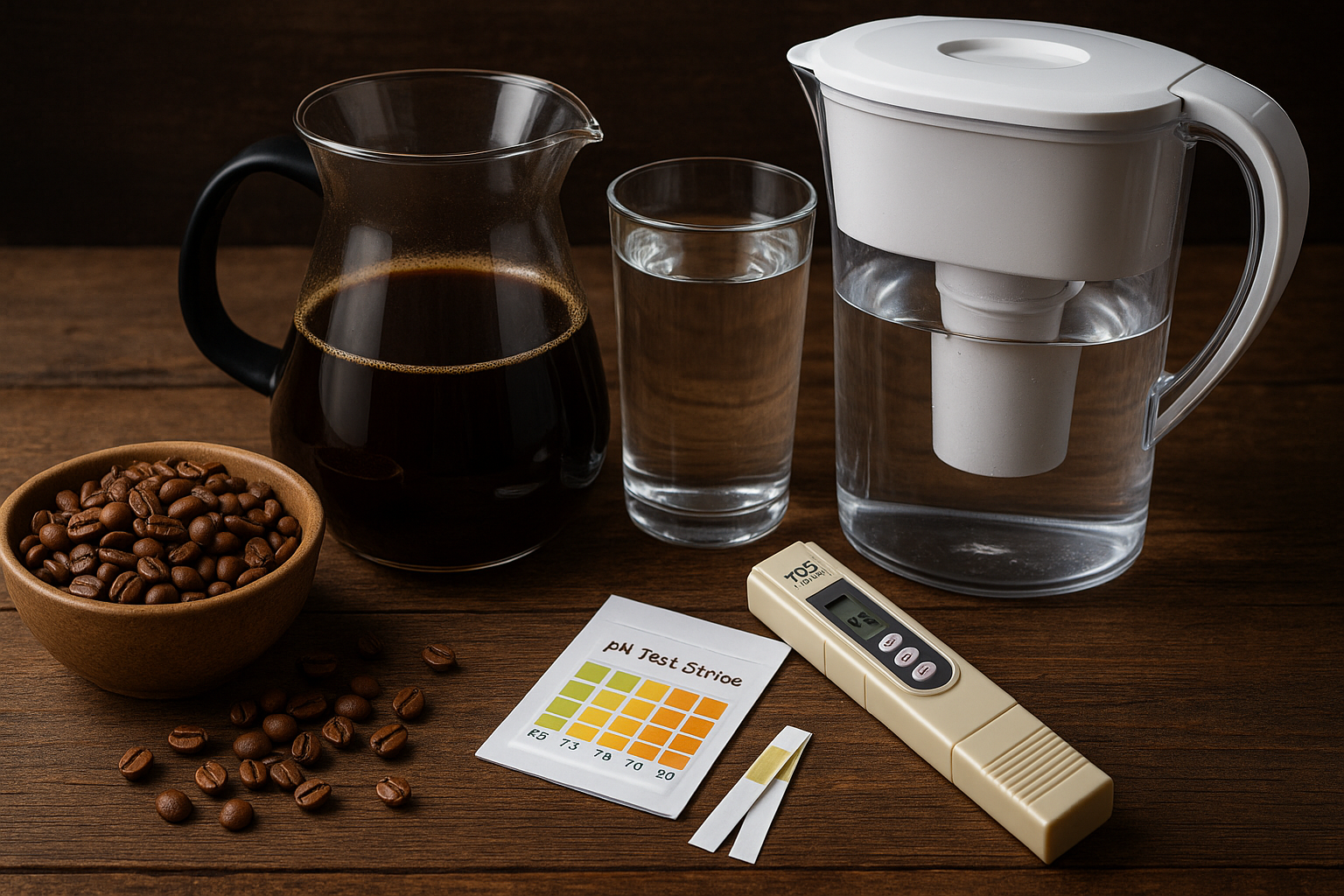If you’re investing in great coffee beans, carefully measuring grind size, and using proper brewing techniques, but still find your coffee lacking, the answer might be right from your tap: water.
Water makes up about 98% of your coffee, so its quality dramatically affects taste. Using the wrong water can flatten flavors, introduce unpleasant notes, and waste good coffee. This article explores how water quality impacts your brew and what you can do at home to ensure your water enhances, not ruins, your coffee.
Why Water Matters in Coffee Brewing
Water is the solvent that extracts flavors, oils, acids, and aromatic compounds from the coffee grounds. But water isn’t just H₂O—it’s full of minerals, chemicals, and impurities that influence extraction.
- Too many minerals = over-extraction or bitter notes.
- Too few minerals = under-extraction or weak flavor.
- Contaminants or chlorine = off-flavors that mask delicate coffee notes.
Understanding the composition of your water is the first step toward improving your coffee’s flavor.
What Is “Good” Water for Coffee?
The Specialty Coffee Association (SCA) offers specific standards for ideal brewing water:
- Total Dissolved Solids (TDS): 75–250 ppm (150 ideal)
- Calcium Hardness: 50–175 ppm (70–85 ideal)
- pH level: 6.5–7.5
- No chlorine or contaminants
These numbers might sound technical, but they’re worth paying attention to—especially if you’re serious about great coffee.
Key Water Components Explained:
- Hardness: Comes from minerals like calcium and magnesium. Some hardness is beneficial for extraction and flavor.
- pH: Measures acidity. Water too acidic or too alkaline can distort coffee’s natural balance.
- Chlorine: Common in municipal tap water, it kills bacteria—but also flavor. It must be removed.
- TDS (Total Dissolved Solids): Measures the total amount of minerals in your water. Affects how much of the coffee is extracted.
Types of Water and Their Effects on Coffee
Tap Water
Tap water varies significantly by location. In some areas, it’s perfectly fine for brewing; in others, it can be full of chlorine, excessive minerals, or sediments.
Pros:
- Convenient
- Free or low-cost
Cons:
- Quality can vary widely
- May contain chlorine or heavy minerals
- Can cause inconsistent results
Tip: Use a simple home water test or check your city’s water quality report to see if your tap water is suitable.
Filtered Water
Using a charcoal or carbon filter pitcher like Brita removes chlorine, odors, and some sediments, improving the taste and neutrality of the water.
Pros:
- Easy to use
- Removes basic contaminants
- Affordable for everyday use
Cons:
- Doesn’t remove all minerals
- Limited lifespan of filters
Bottled Spring Water
Bottled spring water is naturally filtered through rock and soil and typically has a balanced mineral content, making it suitable for coffee brewing.
Pros:
- Consistent quality
- Balanced minerals
- Readily available
Cons:
- Generates plastic waste
- Expensive over time
Distilled Water
Distilled water is pure H₂O with no minerals at all. While it may sound ideal, it’s not recommended for coffee—it lacks the minerals needed for proper extraction and may produce flat-tasting coffee.
Pros:
- Completely neutral
- No contaminants
Cons:
- Poor extraction potential
- Not recommended without mineral rebalancing
Reverse Osmosis (RO) Water
RO systems remove almost all contaminants and minerals. Similar to distilled water, it may require remineralization to perform well in coffee brewing.
Pros:
- Very clean
- Customizable (with mineral additions)
Cons:
- Can be too “empty”
- Expensive system setup
- Wasteful in water usage
How to Test Your Water Quality at Home
You don’t need a lab to understand your water’s quality. Here are simple options:
- TDS meter: Affordable and shows the total mineral content (in ppm).
- Water test strips: Test for chlorine, pH, hardness, and more.
- Local water report: Most municipalities offer detailed water quality reports online.
Target Range:
- TDS: 75–150 ppm
- pH: around 7.0
- Chlorine: 0
How Poor Water Quality Affects Coffee
Too Hard (High Minerals)
- May cause bitter, chalky flavors
- Can lead to scale build-up in coffee equipment
- Reduces lifespan of machines
Too Soft (Low Minerals)
- May result in under-extracted coffee
- Weak body and flavor
- Poor aroma development
Chlorine in Water
- Muted flavors
- Bitter or chemical taste
- Overpowers coffee’s natural complexity
How to Improve Water for Coffee at Home
1. Use a Water Filter
A carbon-based water pitcher or faucet filter is the easiest way to remove chlorine and sediment. It doesn’t balance minerals perfectly but makes a noticeable improvement.
2. Try Third Wave Water
This product offers pre-measured mineral packets you add to distilled water. It reintroduces ideal minerals for coffee brewing.
Pros:
- Perfect mineral balance
- Trusted by professionals
Cons:
- Requires buying distilled water and packets
- Higher ongoing cost
3. Blend Your Own Water
Advanced home brewers may blend distilled water with a small amount of mineral-rich spring water to achieve the right balance.
Example Ratio:
1 liter of distilled water + 250 ml of spring water = approx. 120 ppm TDS
4. Invest in a Water Softener
For very hard water, consider installing a home water softener or RO system. This is more expensive but effective for overall kitchen and brewing use.
Maintaining Your Equipment
Hard water not only affects flavor but causes scale build-up in kettles, espresso machines, and brewers. This can:
- Decrease efficiency
- Shorten lifespan
- Alter temperature control
Descale your equipment regularly, especially if you’re using tap or hard water.
Does Water Temperature Matter Too?
Yes! In addition to water quality, temperature plays a vital role in extraction. Ideal range is:
- 90–96°C (195–205°F)
Water below this range under-extracts coffee; above it risks over-extraction or bitterness. Always preheat your kettle or use a temperature-controlled device for consistency.
Final Tips for Better Coffee with Better Water
- Always smell and taste your water before brewing. If it tastes off, your coffee will too.
- Use filtered water as your default.
- Avoid distilled or RO water unless you’re adding minerals.
- Descale your equipment every 2–3 months, depending on water hardness.
A Better Brew Starts with Better Water
You can have the freshest beans and most precise brewing setup, but if your water is poor, your coffee will never reach its full potential. Water may be invisible in your cup, but its influence is profound. Make water a priority, and you’ll elevate every sip of your home-brewed coffee.

Marcelo Oliveira is a coffee enthusiast and content creator specializing in barista skills, brewing methods, equipment reviews, coffee-related health insights, and fascinating curiosities from the coffee world. With a deep passion for every step of the brewing process, he turns technical knowledge into accessible and engaging content for both beginners and seasoned coffee lovers. Marcelo’s goal is to help readers appreciate the full experience of coffee—from bean to cup.
